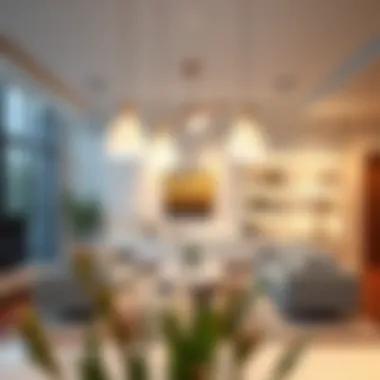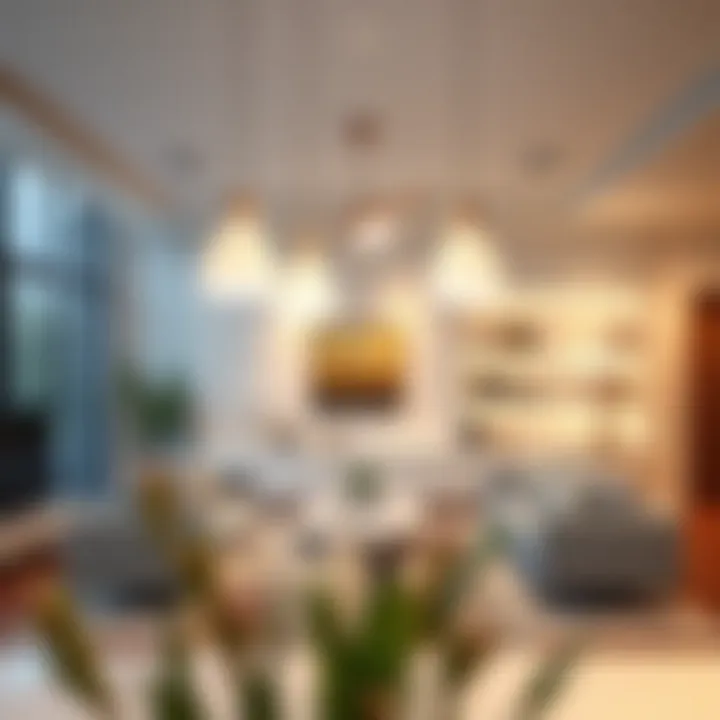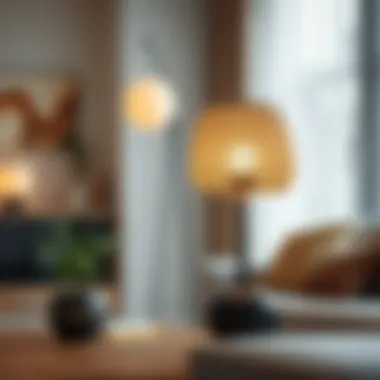Choosing the Ideal Lamp for Your Living Room


Intro
Choosing the right lamp for your living room is more than just a decorative decision. It's about creating a space that reflects your style and meets your functional needs. Light can elevate a room's ambiance, highlight decorations, and affect how we feel in that space. Therefore, it makes sense to dive into the elements that contribute to excellent lighting.
Understanding the role of lamps in living room design is essential. They are not merely sources of light; they serve as focal points and contribute to the overall aesthetic. Before you embark on your quest for the perfect lamp, consider the various factors that play a crucial role in your selection process.
This comprehensive guide aims to provide you with a robust framework for choosing the ideal lamp. We'll cover different types of lamps available, explore the materials used in their construction, discuss ideal placement strategies, and touch on the world's current design trends. Our focus is to arm you with all necessary knowledge to make informed choices that enhance your living space's comfort and style.
Through this exploration, we aim to highlight the importance of aligning practical needs with design elegance. Whether you’re a homeowner looking to revamp your space or a designer searching for the perfect accent piece, the insights here will illuminate your path to finding the right lamp.
As we navigate through each section, you'll find both practical tips and insights on the latest trends that can give your living room that spark of inspiration you’ve been looking for.
Understanding the Role of Lighting in Living Rooms
Lighting is more than just a way to see in the dark; it's a fundamental element that shapes the overall ambiance and feel of a living room. When you step into your living area, lighting is usually the first thing that registers with you, creating a mood that can make the space inviting or off-putting. This section dives into why understanding the role of lighting isn’t just essential; it’s crucial for homeowners, designers, and decorators alike who want to create a harmonious living space.
The Psychological Impact of Lighting
The psychology of lighting is a fascinating subject. Different types of light can evoke different emotional responses. For instance, think of a warm, soft glow from a lamp; it instantly creates a sense of comfort and relaxation. On the opposite end, harsh fluorescent lighting might stir anxiety or discomfort.
Research suggests that light can influence our feelings and behaviors. An inviting atmosphere often promotes social interactions, whereas stark lighting can sometimes dull the mood. Consider the following:
- Warm light tends to make people feel nurtured, encouraging conversations.
- Cool light can help individuals focus and energize a space, ideal for busy household activities.
In the context of a living room, the psychological impact of light should be a top consideration. Placing lamps with varying light temperatures allows for moments of relaxation as well as productivity, ultimately enhancing the experience of those who inhabit the space.
Functional versus Ambient Lighting
When it comes to lighting, it’s essential to distinguish between functional and ambient lighting, as each serves distinct purposes in a living room.
- Functional lighting focuses on tasks or areas that require direct illumination. Think of a bright table lamp next to your reading chair or under-cabinet lighting revealing the surfaces of your workspace. This type of light enhances visibility and makes performing daily activities easier.
- Ambient lighting, on the other hand, envelops a room in a soft glow. This illuminates the overall space, avoiding harsh shadows and creating a more relaxed atmosphere. Ceiling fixtures or floor lamps that diffuse light create this ambiance.
An effective lighting plan combines both functional and ambient light. Homeowners should think about how light will be layered throughout the room, allowing for both utility and comfort.
Creating a Focal Point
Focal points in a living room—like a stunning piece of art or, in this case, a well-placed lamp—can transform a space dramatically. A well-chosen lamp can serve as a visual anchor, drawing attention and enhancing room aesthetics. Here are some strategies to create focal points using lamps:
- Position strategically: Place a floor lamp beside a sofa or an accent chair to naturally draw the eye.
- Choose statement lamps: Go for bold designs or colors that complement the decor yet stand out on their own.
- Height variation: Mixing lamp heights—like a tall arc lamp next to lower furnishings—can create visual interest and make the room feel more dynamic.
Ultimately, the right lamp can highlight the best aspects of a room, turning good design into great design. Effective placement and selection harness the power of light, adding drama and intrigue to any living space.
"A lamp is more than just a source of light; it can change the entire fabric of a room."
Understanding the role of lighting is foundational to creating a living room that functions well and feels good. It requires an understanding of how different types, styles, and setups can serve emotional and practical purposes simultaneously.
Types of Lamps for Living Spaces
When it comes to lighting a living room, the types of lamps you choose play an essential role in both form and function. Selecting the right lamp can transform not just the space, but also the atmosphere. Different lamps bring their own unique characteristics and benefits, catering to varying needs, styles, and moods.
Table Lamps: Versatile and Stylish
Table lamps are the quiet achievers of living room lighting. They come in various styles, from sleek modern designs to more traditional options. The beauty of table lamps is their versatility—they can fit into almost any space. Set one atop a side table next to a cozy chair for a reading corner, or place a pair of matching lamps on both ends of a sofa for symmetry.
Benefits of Table Lamps:
- Task Lighting: Table lamps provide focused light where it’s needed most, perfect for reading or working on projects.
- Aesthetic Appeal: They can serve as statement pieces. A unique lamp can add character to your decor.
- Flexible Placement: Easy to move around, you can change their locations to refresh the look of your space without breaking a sweat.
Floor Lamps: Height and Presence
Floor lamps are often seen as the bold statement-makers in the lighting family. Their stature allows them to offer substantial illumination and serve as visual anchors within a room. With various styles available—from arched designs to tripod stands—floor lamps can either blend in or stand out, depending on your design preferences.
"A well-placed floor lamp can turn a dark corner into a favorite nook."
Key Considerations for Floor Lamps:
- Height Variability: Choose a lamp that fits your furniture height; a tall floor lamp can draw eyes upward, creating an illusion of higher ceilings.
- Light Spread: These lamps often provide both ambient and task lighting, making them suitable for various activities.
- Room Dynamics: Properly positioned, floor lamps can direct attention to art or architectural features, enhancing the overall design.


Wall Lamps: Space-Saving Solutions
Wall lamps, or sconces, are fantastic for areas where floor or table space is limited. These fixtures often offer a clean, modern appearance that can complement any living room style. They can be mounted at different heights to create ambient lighting or focused beams for specific activities.
Advantages of Wall Lamps:
- Space Efficiency: These lamps free up space on tables and floors, allowing for a less cluttered look.
- Layered Lighting: When used in combination with other lamps, wall sconces help build a multi-dimensional lighting scheme.
- Design Cohesion: When chosen thoughtfully, wall lamps can enhance the aesthetics of the room, adding character and cohesion to your design theme.
Ceiling Fixtures: From Chandeliers to Pendants
Ceiling fixtures are a crucial part of any living room's lighting scheme. They not only provide overhead lighting but also often serve as central decor pieces that can define the style of the entire room. From grand chandeliers that exude elegance to minimalist pendants that add a touch of modernity, the options are endless.
Why Ceiling Fixtures Matter:
- Illumination: These fixtures can cast light across the entire space, creating a welcoming ambiance.
- Aesthetic Centerpiece: Choosing a striking chandelier or a series of pendant lights can turn a plain ceiling into a focal point.
- Versatile Styles: With styles ranging from rustic to contemporary, there’s a ceiling fixture fit for every taste.
Materials and Finishes in Lamp Design
When it comes to choosing a lamp for your living room, the materials and finishes can make or break the entire aesthetic. The right lamp isn't just about function; it's also an expression of your personal style. The materials used can impact the vibe of the room, how light disperses, and even durability. Let's take a closer look at the various materials available and their unique characteristics.
Metal Lamps: Durability and Modern Appeal
Metal lamps are often the go-to for those seeking durability merged with clean lines and a modern touch. Whether you opt for brass, stainless steel, or aluminum, metal lamps can significantly uplift your living space.
- Durability: Metal is a robust material that stands the test of time, making it ideal for high-traffic areas.
- Modern Appeal: A sleek metal finish can convey a contemporary look, catering to those with minimalistic tastes.
You might notice a growing trend towards matte black or brushed finishes, which add an extra layer of sophistication. Plus, metal fixtures often come with adjustable features, allowing you to tailor the light to your needs effortlessly.
Glass Lamps: Transparency and Light Play
Glass lamps bring their flair by maximizing light reflection and adding a touch of elegance to your living room. With various textures and colors available, glass can easily become a focal point.
- Transparency: The clear or tinted glass allows for light to diffuse beautifully, creating a welcoming atmosphere.
- Light Play: Textured glass will cast intriguing shadows and patterns on walls, enhancing the overall aesthetic.
Be cautious though; glass lamps can be fragile, so keep them away from high-traffic areas where accidental bumps might lead to mishaps.
Fabric Lampshades: Softness and Texture
The choice of fabric lampshades is vital, as they offer softness and warmth that metal or glass simply cannot achieve. A well-chosen fabric can add layers of texture to your space, transforming the ambiance entirely.
- Softness: Fabric provides a warm glow that's perfect for cozy evenings, contrasting sharply with harsher light from bare bulbs.
- Texture Variety: From linen to silk, several fabric types allow you to play with colors and textures, creating a more personalized look.
However, do take into account potential maintenance. Fabric can catch dust, and those with pets may find that they attract fur, so wash or replace shades periodically.
Wooden Elements: Warmth and Natural Aesthetics
Wooden lamps bring a dose of nature indoors, providing warmth and a unique organic aesthetic. They have a charm that can soften modern designs and blend seamlessly with rustic or Scandinavian styles.
- Warmth: Wood is inherently warm, making any living room feel more inviting.
- Natural Aesthetics: The grains and knots in wood lend each lamp a unique appearance, ensuring no two are exactly alike.
Consider pairing a wooden lamp with softer, cohesive elements in the room for a well-rounded look. Additionally, ensure that the finish suits your overall décor, from polished looks to more rustic, unfinished appearances.
"Choosing the right materials for your lamps is crucial; they can dictate the mood, functionality, and overall look of your living room. A well-lit space is not just about brightness but about ambiance and style."
When exploring lamp designs, it's essential to think critically about the materials and their finishes. Each has its perks and potential drawbacks. Balancing aesthetics with practical considerations is the key to finding just the right lamp to illuminate your living room.
Determining the Right Size and Scale
Choosing the right lamp for your living room involves more than just aesthetics; it’s also about ensuring that the lamp fits well within its surroundings. Correct size and scale can drastically influence both the functionality and ambiance of a space. A lamp that is too large can overwhelm a room, while one that's too small might fail to provide adequate illumination or visual interest.
When determining size, it's vital to pay attention to proportion in relation to the room's dimensions, your furniture layout, and the other design elements at play. This balance can create a harmonious environment, enhancing the beauty of the space without causing visual clutter.
Room Dimensions and Proportions
Understanding your room's dimensions is the first step in selecting the right lamp. An average-sized living room with 10-foot ceilings, for instance, can manage more substantial lighting fixtures without feeling cramped. However, compact spaces require careful consideration to avoid feeling weighed down by oversized lamps. It’s beneficial to measure your room before heading out for shopping. A quick tip?
"Use painter's tape to outline the area where the lamp will sit, giving a realistic size guide on the floor."
By evaluating the square footage and unique features—like architectural elements or furniture placements—you can make a more informed decision. Aim for a lamp height that complements your seating arrangements and overall decor theme.


Height Considerations for Different Lamps
The height of your lamp should serve practical purposes while also aligning with the decor. Table lamps, for example, are typically best positioned between 58-64 inches from the floor to the base of the shade when seated. In contrast, floor lamps offer a varied range from 58 to 72 inches—but where you place them can change how they are perceived within the space.
Think about the following:
- Reading Areas: Position lamps so that the light hits the page without strain. Standalone or arc lamps often provide a better solution for such spots.
- Mood Lighting: Low-level lamps can create a cozy corner, inviting relaxation and warmth. Ensure those lamps do not obstruct sightlines across the room.
Getting the height right not only fulfills practical lighting functions but also adds a layered aspect to your decor.
Balancing Lamp Size with Furniture Layout
Finally, consider how your chosen lamp interacts with existing furniture. A lamp's size should complement rather than dominate other pieces. Too large of a lamp near a delicate side table might create visual imbalance, while a too-small lamp can get dwarfed by bulky upholstery.
Here are some pointers for achieving balance:
- Visual Weight: Heavy wooden lamps look great next to similarly sturdy sofas or chairs, while slender metal or glass lamps can soften heavier furniture pieces.
- Group Similar Elements: If possible, match lamp styles with other lighting elements in the room. This creates a sense of coordination throughout and can help make different areas feel unified.
Striking the right balance in size and scale transforms a room, making spaces feel inviting and thoughtfully curated.
Lamp Placement Strategies
When it comes to creating the perfect ambiance in your living room, understanding lamp placement strategies is crucial. Proper placement can make or break the feel of the space, enhancing functionality while increasing aesthetic appeal. Lighting not only serves the practical purpose of illuminating your room, but it also sets the mood for gatherings, reading, or simply relaxing after a long day. Therefore, a thoughtful approach to lamp placement is essential.
"Well-placed lighting can transform a room from drab to fab, setting the stage for both lively conversations and quiet evenings."
Let’s dig into specific strategies that can elevate your living room’s lighting experience.
Optimal Locations for Table Lamps
Table lamps are the unsung heroes of living room lighting. They offer flexibility and styles that can seamlessly blend into various decors. The optimal locations for table lamps usually include:
- Side Tables Nearby Seating: Next to the sofa or an armchair, a table lamp provides focused illumination for reading or browsing on your phone. A warm glow near a cozy chair can beckon you to unwinding with a good book.
- Console Tables and Buffets: If you have a console table against the wall, placing a table lamp here not only adds style but also draws attention to the pieces displayed on it, be it family photos or decorative items.
- Bedroom Escapades: While this might be a guide about living rooms, remember that sometimes the best table lamps can grace a bedside table as well. A soft light just beside the bed can create a calming atmosphere for winding down.
Floor Lamp Positioning for Maximum Impact
Floor lamps are not just towering bastions of light; they're statement pieces that anchor a room. When positioning them, consider these key places:
- Angles of Interest: Placing a floor lamp in a corner can visually expand the room's dimensions. Consider a lamp that arcs gently over an armchair for both style and efficient lighting.
- Nook Enrichment: If you have a reading nook or a little space that feels under-utilized, a floor lamp can breathe life into it. A well-placed lamp here can create an intimate zone where one would enjoy solitude.
- Grouping with Other Furniture: Pair a floor lamp with other furnishings like a side table and a chair to create a layered look. This not only provides light in various areas but also gives dimension to your decor.
Accent Lighting and Its Placement
Accent lighting adds depth and character to your living room. This can include anything from spotlights on art pieces to strategically placed lamps. Here’s how to maximize impact:
- Highlighting Artwork: If you have a piece of art or a gallery wall, consider placing an accent lamp or spotlight near it. This draws the eye and elevates the aesthetic of the wall.
- Behind the Sofa Illumination: A lamp placed behind a sofa can create an inviting glow. This soft backlight can also give the illusion of more space, making your living area feel more expansive.
- Mood Lighting in Nooks and Crannies: In tight spaces, accent lights can illuminate otherwise overlooked areas, creating a sense of discovery as you move throughout the room. This could be near bookshelves or in corners filled with supporting furniture.
Trends in Living Room Lighting Design
Understanding the latest trends in living room lighting design is crucial for anyone looking to enhance their home’s ambiance. In the ever-evolving sphere of interior decor, lighting serves as more than just a functional necessity; it helps establish the overall mood and style of a space. Focusing on current trends allows homeowners and designers to make informed decisions while ensuring their choices resonate with contemporary aesthetics and practical needs.
Sustainable Lighting Solutions
Sustainability is no longer just a buzzword; it’s a lifestyle choice many are embracing. When it comes to lighting, sustainable solutions have regularized themselves in homes worldwide. Using energy-efficient bulbs, such as LED or CFL, drastically reduces power consumption. These bulbs not only save money on electricity bills but also have a longer lifespan compared to traditional incandescent bulbs.
Moreover, many manufacturers are now focusing on eco-friendly materials in their lamp designs. For example, lamps made from recycled metals or sustainably-sourced wood are gaining popularity. Homeowners can also consider fixtures that utilize solar energy or incorporate motion sensors to reduce energy waste, bringing practicality and nature together seamlessly.
For anyone curious about the specifics of sustainable options, here are some choices to consider:
- Energy Star rated bulbs: These bulbs meet strict efficiency guidelines set by the U.S. Environmental Protection Agency.
- Solar-powered garden lamps: Perfect for outdoor settings, these lamps harness the sun to provide lighting without using electricity.
- Smart home integration: Automating lamps to turn off when not in use helps cut down on energy consumption.
Smart Lighting Technologies
With the rise of technology in our daily lives, smart lighting systems have taken center stage in modern interiors. These systems offer convenience and versatility that traditional lighting simply can't match. Homeowners can now control their lights with ease through smartphone apps or voice commands via smart assistants like Amazon Alexa or Google Assistant.
One trend in smart lighting involves color-changing bulbs. These can adapt to the owner’s mood or environment, shifting from bright, cool light for productivity to soft, warm light for relaxation. Additionally, programmable lighting schedules give homeowners the flexibility to control when and how their spaces are illuminated.
Consider utilizing these smart technologies:
- Location-based automation: Lights that turn on automatically when you enter a room.
- Integration with security systems: Lights can simulate presence and deter potential intruders.
- Mood settings: Pre-set scenes that adjust brightness and color temperature for activities like reading, hosting, or family movie night.


Layered Lighting Techniques
Layered lighting is a technique that involves the strategic combination of ambient, task, and accent lighting to create depth and intrigue in a living room. This approach allows for versatility in lighting design, as it caters to different needs throughout the day. To garner this effect, layers should be mixed effectively, depending on the room’s use.
For instance, a living room might utilize:
- Ambient lighting: Overhead fixtures or recessed lighting provides a soft overall glow to the room.
- Task lighting: Table lamps or floor lamps ensure that individual areas are well lit for activities like reading or working.
- Accent lighting: Wall sconces or spotlighting can highlight artwork or architectural features, thus creating visual interest.
When combined, these lighting layers bring out the best in a room’s decor and encourage a harmonious blend of style and functionality. The magic lies in adjusting these layers based on the time of day, the event, or even your mood.
"Layered lighting is about creating an atmosphere and achieving that inviting feel, inviting people to linger a little longer."
Utilizing these trends in living room lighting design not only elevates the beauty of a space but also addresses the functional needs of the residents. From choosing sustainable options to embracing smart technologies and applying layered techniques, these elements play a pivotal role in crafting an inviting and adaptable living area.
Selecting the Right Bulbs
Choosing the right bulbs for your living room lamps is a crucial step in creating an inviting and functional space. The bulbs can impact everything, from the warmth and mood of the room to your energy bills. When picking bulbs, it’s not just about the light they emit; it's about ensuring they enhance the overall aesthetic and serve your practical needs. To make informed decisions, one must understand a few key elements:
- Brightness: Not all light bulbs are created equal. The measure of light output used is lumens, not watts. Brightness varies significantly among different types of bulbs, affecting how spaces feel and look.
- Color temperature: Illumination can either amplify the cozy vibes or reveal stark contrasts in design. Understanding warm and cool light is important for achieving balance.
- Energy efficiency: With rising energy costs, selecting bulbs that save on consumption is no longer an option; it’s a necessity.
Unraveling these layers of information will equip homeowners and designers alike with the knowledge needed to select the most suitable lighting for their living area.
Understanding Lumens and Watts
Traditionally, many relied on the wattage of a bulb to gauge its brightness. However, that’s like using a ruler to measure the flavor of a meal – it just doesn't cut the mustard. Instead, lumens are the star of the show. A higher lumen count means a brighter light, while a lower count equates to a dimmer bulb.
For example, if a living room is meant for activities like reading or entertaining, you might aim for bulbs that emit somewhere around 800 lumens for a warm, inviting ambiance combined with utility. On the flip side, if the lighting’s solely for mood setting during a cozy evening, 450 lumens could do the trick.
- Common lumens ranges:
- Dim lighting: 100-200 lumens
- Task lighting: 300-800 lumens
- Bright lighting: 800+ lumens
This understanding will not only help in choosing the right bulbs but also in determining how many to use in a space to achieve your desired luminosity.
Color Temperature: Warm vs. Cool Light
When discussing light in a living room, one cannot overlook color temperature. Measured in Kelvin (K), this concept can shift the overall aura of a room from jubilant to serene.
- Warm light (2700K-3000K): This range creates a cozy and intimate atmosphere, ideal for a living room setting where relaxation is key. It mimics a soft glow reminiscent of candlelight.
- Cool light (3500K-5000K): On the other hand, the brighter end of the spectrum gives a crisp, alert feeling. While great for tasks like reading, it can feel a bit too sterile for a space meant for unwinding.
It's essential to think about how the type of light you choose complements other elements in the room: furniture, wall colors, and decor styles. The synergy between light and design brings an enveloping warmth to your living space or can leave it feeling disjointed.
"The light bulb doesn’t just illuminate the room; it reveals your style and mood."
Energy Efficiency Considerations
In today’s world, being energy-efficient is like having functional art hanging on your walls. It not only looks good but also feels good for the wallet and the planet. Making sensible choices about light bulbs can lead to savings and an eco-friendly touch to your setting.
- Incandescent bulbs: Traditionally popular, but they consume a high amount of energy and have a shorter lifespan.
- CFLs (Compact Fluorescent Lamps): More efficient than incandescents, these last longer and use considerably less energy. However, the light quality can be hit or miss.
- LEDs (Light Emitting Diodes): These bulbs are the heavyweights in energy savings, offering long life and a broad spectrum of color temperatures. Though they may come at a higher initial cost, the reduction in electricity bills makes them a wise investment.
Incorporating energy-efficient options reduces footpring and provides the illumination needed without the headache of pricy electric bills. Being conscious about your choices not only enhances a room’s aesthetic but does so while promoting sustainability.
Finale: Harmonizing Functionality and Aesthetics
Lighting goes beyond mere illumination; it has the power to transform the atmosphere of a living room, marrying functionality with aesthetics in an elegant dance. Selecting the right lamp isn’t just about picking one that looks nice; it’s about understanding how form and function intertwine to enrich both the space and the experience of those who inhabit it.
The lamps in your living room reflect your personality and style. Think about how a mid-century modern floor lamp can juxtapose against a cozy, traditional couch. It brings in a conversation piece, provoking thoughts on style evolution and taste. Meanwhile, great functionality comes from ensuring that your lighting serves its purpose: be it reading the latest thriller or setting a warm ambiance for movie night.
Final Thoughts on Lamp Selection
When it comes to lamp selection, there are a few key elements to consider:
- Purpose: Ask yourself what you'll be using the lamp for. Is it for reading, ambiance, or maybe highlighting artwork?
- Scale: Visual balance is crucial. A lamp that's too small can appear lost in a sizable room, while an oversized piece might overwhelm a modest space.
- Design: Reflect your style. Whether minimalistic, vintage, or sleek contemporary, select a design that you resonate with.
Many homeowners underestimate how vital proper lighting can be. From the brightness of the bulb to the shade's color, every detail contributes to the overall harmony of the room. You want a cohesive look that feels welcoming and comfortable. And don't shy away from experimenting with different lamp types and placements until you find what feels just right.
Encouraging Individual Style
Your living room should narrate a story—your story. Choosing the right lamp is an extension of your individuality, allowing you to convey your unique taste and preferences. Incorporating personal style into lighting decisions can be as simple as mixing vintage finds with modern pieces to create an eclectic look.
You might consider:
- Custom lampshades: Opt for patterns that speak to you, perhaps something tied to your travels or personal experiences.
- DIY lamps: Have a flair for the creative? Craft your own lamp from materials that resonate with you.
- Layer lighting: Don't settle for one lamp; incorporate various sources of light at different heights and intensities to build warmth while highlighting your unique decore.
It’s about more than just utility; it’s about feeling at home in your own space. The right lamp can do wonders by adding comfort and character, reinforcing that coziness often missed in sterile showrooms. Embrace your tastes. Make choices that are authentic to you, and don’t hesitate to step outside conventional norms. After all, the heart of a truly inviting living room lies in your personal touch.







